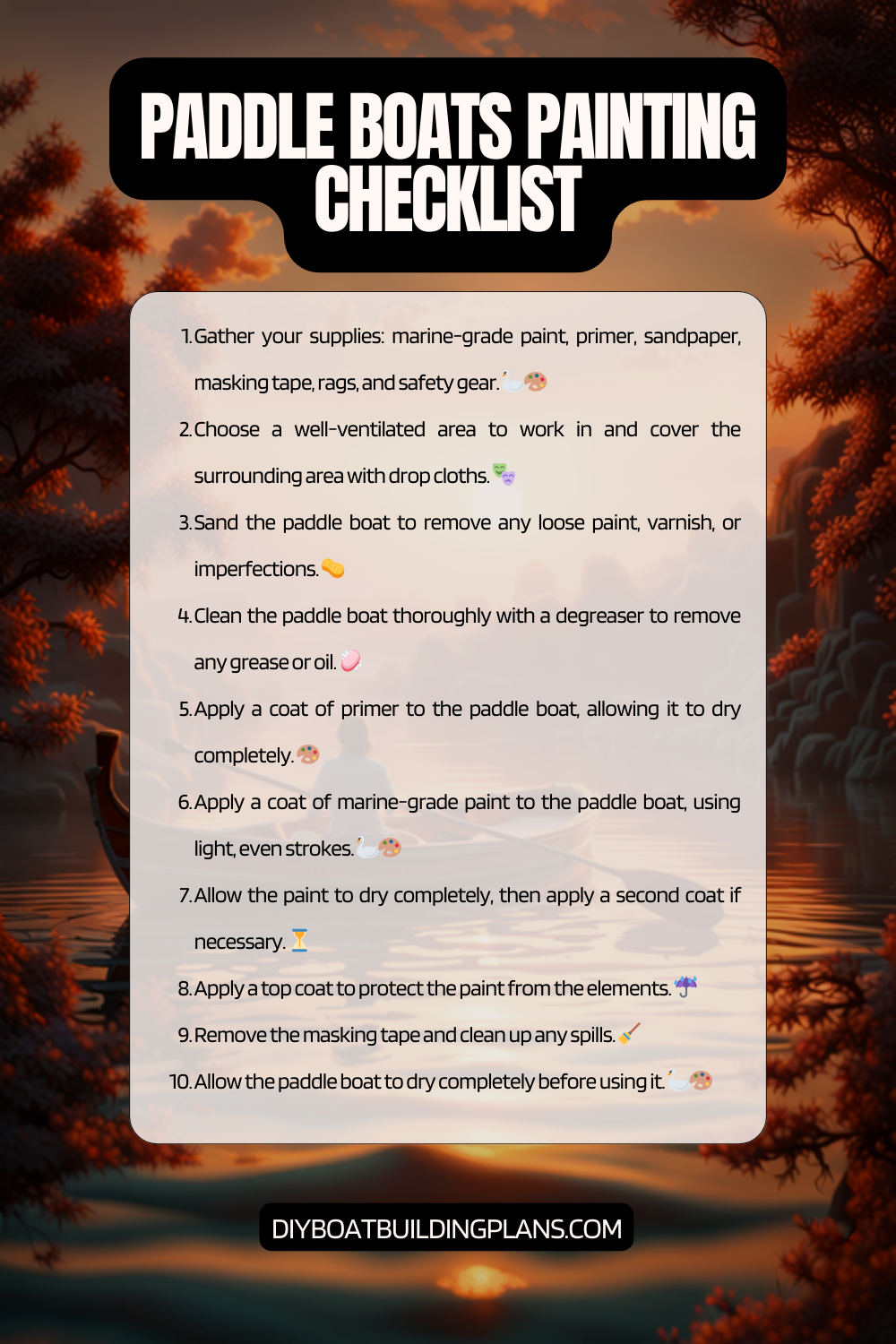Overview of Paddle Boat Painting Tips
Paddle boats are not only a means of transportation but also a source of joy and relaxation. Whether you use your paddle boat for leisurely rides on the lake or for fishing trips, it is important to keep it well-maintained, and painting plays a crucial role in this. A well-painted paddle boat not only enhances its appearance but also protects it from the harsh elements of nature.
The benefits of a well-painted paddle boat are numerous. Firstly, it adds a touch of elegance and beauty to your boat, making it stand out on the water. A fresh coat of paint can transform an old and worn-out paddle boat into a stunning vessel that catches everyone’s attention. Secondly, painting your paddle boat helps to protect it from the damaging effects of sun, water, and other environmental factors. The paint acts as a barrier, preventing rust, corrosion, and fading caused by prolonged exposure to these elements. Lastly, a well-painted paddle boat increases its resale value. If you ever decide to sell your boat in the future, a well-maintained paint job will attract potential buyers and fetch you a higher price.
Key Takeaways
- Choose the right paint for your paddle boat to ensure durability and longevity.
- Proper preparation, including sanding and priming, is crucial for a smooth and professional finish.
- Use painting techniques such as rolling, brushing, and spraying to achieve the desired look.
- Don’t forget to protect your paddle boat with a clear coat to prevent damage from UV rays and water.
- Regular maintenance, including cleaning and touch-ups, will keep your paddle boat looking great for years to come.

Choosing the Right Paint for Your Paddle Boat
When it comes to choosing the right paint for your paddle boat, there are several factors to consider. Firstly, you need to decide between oil-based and water-based paints. Oil-based paints provide better durability and protection against water, but they take longer to dry and require more effort for cleanup. On the other hand, water-based paints are easier to work with and dry faster, but they may not offer the same level of protection as oil-based paints.
Another important consideration is the type of paint finish you want for your paddle boat. Glossy finishes provide a high shine and are easier to clean, but they may show imperfections more prominently. Satin or matte finishes offer a more subtle and smooth appearance, but they may require more maintenance to keep them looking their best.
Additionally, you should choose a paint color that suits your personal preferences and complements the overall aesthetic of your paddle boat. Bright and vibrant colors can make your boat stand out, while neutral or classic colors provide a timeless appeal. It is also worth considering the climate and environment in which you will be using your paddle boat, as certain colors may fade or show wear more quickly in harsh conditions.
Preparing Your Paddle Boat for Painting
Before you start painting your paddle boat, it is crucial to properly prepare the surface to ensure a smooth and long-lasting finish. The first step is to clean the boat thoroughly, removing any dirt, grime, or residue that may interfere with the adhesion of the paint. Use a mild detergent and water solution to scrub the surface, and rinse it off with clean water.
Next, if there is any old paint on the boat that is peeling or chipping, it needs to be removed. Use a scraper or sandpaper to gently scrape away the old paint until you reach a smooth surface. Be careful not to damage the underlying material of the boat during this process.
After removing the old paint, inspect the paddle boat for any damages or imperfections that need to be repaired. Fill in any cracks, holes, or dents with an appropriate filler or putty, and sand it down until it is level with the surrounding surface. This step is essential for achieving a flawless paint job.
Lastly, mask off any areas of the paddle boat that should not be painted. This includes hardware, windows, and any other parts that you want to keep free from paint. Use painter’s tape and plastic sheets to cover these areas and ensure clean lines and edges.
Sanding Techniques for a Smooth Finish
| Technique | Description | Advantages | Disadvantages |
| Hand Sanding | Sanding by hand using sandpaper or sanding blocks. | Controlled sanding, good for small areas, inexpensive. | Time-consuming, inconsistent results, can cause fatigue. |
| Power Sanding | Sanding using power tools such as orbital sanders or belt sanders. | Efficient, consistent results, good for large areas. | Expensive, can cause damage if not used properly, noisy. |
| Wet Sanding | Sanding using water to lubricate the surface and prevent dust. | Smooth finish, reduces dust, good for finishing coats. | Messy, requires more time and effort, can cause rust if not dried properly. |
| Buffing | Using a buffing wheel or pad to polish the surface. | High gloss finish, removes scratches and imperfections. | Requires special equipment, can be expensive, can cause heat damage if not used properly. |
Sanding is a crucial step in paddle boat painting as it helps create a smooth surface for the paint to adhere to. It also helps to remove any remaining traces of old paint, dirt, or imperfections. Different sanding techniques are required for different areas of the paddle boat.
For large and flat surfaces, such as the hull or deck, you can use a power sander with medium-grit sandpaper. Move the sander in a back-and-forth motion, following the grain of the wood or fiberglass. Be careful not to apply too much pressure, as it can damage the surface.
For curved or hard-to-reach areas, such as corners or intricate designs, hand sanding is the best option. Use sandpaper with a higher grit to gently sand these areas in a circular motion. Take your time and ensure that all surfaces are smooth and free from any roughness.
After sanding, make sure to remove all dust and debris from the paddle boat. Use a clean cloth or vacuum cleaner to thoroughly clean the surface before moving on to the next step.
Applying Primer to Your Paddle Boat
Applying primer is an essential step in paddle boat painting as it helps create a strong bond between the paint and the surface, improves adhesion, and enhances durability. It also helps to seal any porous areas and provides a smooth base for the paint.
Before applying primer, make sure that the surface is clean and dry. Stir the primer thoroughly to ensure an even consistency. Using a brush or roller, apply a thin and even coat of primer to the entire paddle boat. Work in small sections and avoid over-applying the primer, as it can lead to drips or uneven drying.
Allow the primer to dry completely according to the manufacturer’s instructions. Once dry, lightly sand the surface with fine-grit sandpaper to remove any imperfections or roughness. Wipe away any dust with a clean cloth before proceeding with painting.
Painting Techniques for a Professional Look
When it comes to painting your paddle boat, different techniques are required for different areas to achieve a professional-looking finish. For large and flat surfaces, such as the hull or deck, using a roller is the most efficient method. Start from one end and work your way towards the other, applying even pressure and overlapping each stroke slightly to avoid visible lines.
For smaller and more intricate areas, such as railings or trim, a brush is the best tool. Use a high-quality brush with synthetic bristles for smoother application. Apply the paint in thin and even coats, using long and smooth strokes. Take your time and ensure that the paint is evenly distributed without any drips or brush marks.
To achieve a flawless finish, it is important to maintain a wet edge while painting. This means that you should avoid letting the paint dry completely between coats. Work in small sections and blend each stroke into the previous one while the paint is still wet. This technique helps to create a seamless and uniform appearance.
Tips for Painting Hard-to-Reach Areas
Painting hard-to-reach areas of your paddle boat can be challenging but with the right techniques, it can be done effectively. One tip is to use an angled brush or a small foam roller for better access to tight corners or narrow spaces. These tools allow you to reach areas that are difficult to paint with a regular brush or roller.
Another tip is to use a mirror or reflective surface to help you see hidden areas while painting. By positioning the mirror strategically, you can get a better view of what you are painting and ensure that no spots are missed.
If possible, disassemble any removable parts of your paddle boat before painting. This will make it easier to access hard-to-reach areas and ensure a more thorough paint job. Take note of how the parts are assembled so that you can easily put them back together after painting.
Lastly, be patient and take your time when painting hard-to-reach areas. It may require more effort and precision, but the end result will be worth it. Use small and controlled brush strokes or foam roller applications to ensure an even and consistent finish.
Adding Graphics and Designs to Your Paddle Boat
Adding graphics and designs to your paddle boat can further enhance its appearance and make it truly unique. There are several ways to add graphics and designs, depending on your preferences and skill level.
One option is to use vinyl decals or stickers. These are pre-cut designs that can be easily applied to the surface of your paddle boat. They come in a wide variety of colors, shapes, and sizes, allowing you to customize your boat according to your taste. Simply clean the surface, peel off the backing of the decal, and carefully apply it to the desired location. Smooth out any air bubbles or wrinkles using a squeegee or a credit card.
If you have artistic skills or prefer a more personalized touch, you can also hand-paint graphics or designs on your paddle boat. Use stencils or freehand techniques to create patterns, images, or lettering. Acrylic paints are a popular choice for hand-painting as they offer vibrant colors and good adhesion to various surfaces. Make sure to use a fine brush for detailed work and take your time to achieve the desired result.
Another option is to hire a professional painter or graphic designer to create custom graphics for your paddle boat. They can help bring your ideas to life and ensure a high-quality finish. This option is particularly suitable for complex designs or if you want a flawless and professional-looking result.
Protecting Your Paddle Boat with a Clear Coat
After painting your paddle boat, it is important to protect the paint job with a clear coat. A clear coat acts as a protective layer, shielding the paint from UV rays, water damage, and other environmental factors. It also adds a glossy finish and enhances the overall appearance of your paddle boat.
Before applying the clear coat, make sure that the painted surface is clean and free from any dust or debris. Stir the clear coat thoroughly to ensure an even consistency. Using a brush or roller, apply a thin and even coat of clear coat to the entire paddle boat. Work in small sections and avoid over-applying the clear coat to prevent drips or uneven drying.
Allow the clear coat to dry completely according to the manufacturer’s instructions. Depending on the type of clear coat used, you may need to apply multiple coats for optimal protection and shine. Sand lightly between each coat to ensure a smooth finish and remove any imperfections.
Download over 500 Boat Plans. Click on the link below.
-->Click Here<--
Maintaining Your Paddle Boat’s Paint Job
To keep your paddle boat’s paint job looking its best, regular maintenance is essential. Here are some tips for maintaining your paddle boat’s paint job:
1. Wash your paddle boat regularly with mild soap and water to remove dirt, salt, or other contaminants that can damage the paint.
2. Avoid using abrasive cleaners or harsh chemicals that can strip away the paint or cause discoloration.
3. Wax your paddle boat at least once a year to provide an extra layer of protection against UV rays and water damage. Choose a marine-grade wax that is specifically formulated for boats.
4. Inspect your paddle boat regularly for any damages or imperfections. Touch up any chips, scratches, or areas of peeling paint as soon as possible to prevent further damage.
5. Store your paddle boat in a covered area or use a boat cover when it is not in use. This will protect it from prolonged exposure to sun, rain, and other elements that can fade or damage the paint.
6. Avoid dragging or scraping your paddle boat on rough surfaces, as this can cause scratches or gouges in the paint.
By following these maintenance tips, you can ensure that your paddle boat’s paint job remains vibrant and protected for years to come.
Paddle Boat Painting Checklist

Conclusion – Paddle Boat Painting Tips
In conclusion, painting your paddle boat is not only a way to enhance its appearance but also a means of protecting it from the elements. A well-painted paddle boat stands out on the water, increases its resale value, and provides long-lasting durability.
When choosing the right paint for your paddle boat, consider factors such as the type of paint, finish, and color that best suit your preferences and the environment in which you will be using your boat. Properly preparing the surface by cleaning, removing old paint, repairing damages, and masking off areas is crucial for achieving a smooth and flawless paint job.
Sanding techniques help create a smooth surface for the paint to adhere to, while applying primer improves adhesion and durability. Different painting techniques are required for different areas of the paddle boat, and attention to detail is key to achieving a professional-looking finish.
Painting hard-to-reach areas can be challenging but with the right tools and techniques, it can be done effectively. Adding graphics and designs further enhances the appearance of your paddle boat, whether through vinyl decals, hand-painting, or professional customization.
Protecting your paddle boat’s paint job with a clear coat is essential for longevity and shine. Regular maintenance, including washing, waxing, touch-ups, and proper storage, ensures that your paddle boat’s paint job remains in top condition.
In conclusion, painting your paddle boat requires careful consideration of various factors and attention to detail. By following the tips and techniques discussed in this article, you can achieve a stunning and long-lasting paint job that will make your paddle boat a true masterpiece on the water.
FAQs – Paddle Boat Painting Tips
What is a paddle boat?
A paddle boat is a type of watercraft that is propelled by a paddle wheel. It is commonly used for recreational purposes such as sightseeing, fishing, and leisurely cruising.
Why should I paint my paddle boat?
Painting your paddle boat not only enhances its appearance but also protects it from the damaging effects of water, sun, and other environmental factors. It also helps to prevent rust and corrosion.
What type of paint should I use for my paddle boat?
It is recommended to use marine-grade paint for your paddle boat as it is specifically designed to withstand the harsh marine environment. It is also important to choose a paint that is compatible with the material of your boat.
How do I prepare my paddle boat for painting?
Before painting your paddle boat, it is important to clean and sand the surface to remove any dirt, grime, or old paint. You should also repair any cracks or dents and apply a primer to ensure proper adhesion of the paint.
What is the best way to apply paint to my paddle boat?
The best way to apply paint to your paddle boat is to use a brush or roller. It is important to apply thin, even coats and allow each coat to dry completely before applying the next one. You should also follow the manufacturer’s instructions for the recommended number of coats.
How do I maintain the paint on my paddle boat?
To maintain the paint on your paddle boat, it is important to regularly clean it with a mild soap and water solution. You should also avoid using abrasive cleaners or tools that can scratch or damage the paint. Additionally, you should inspect the paint periodically for any signs of wear or damage and touch up as needed.


